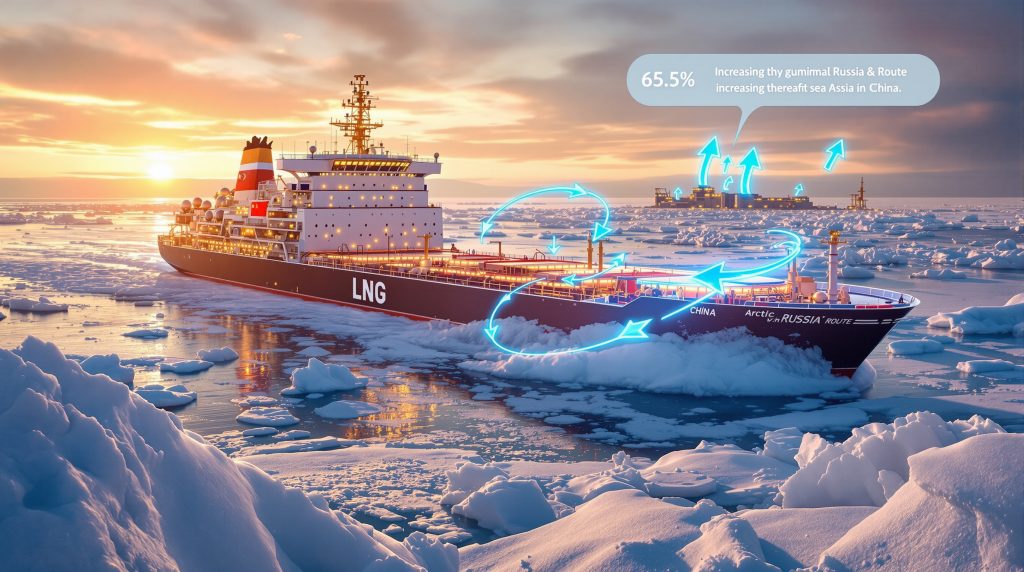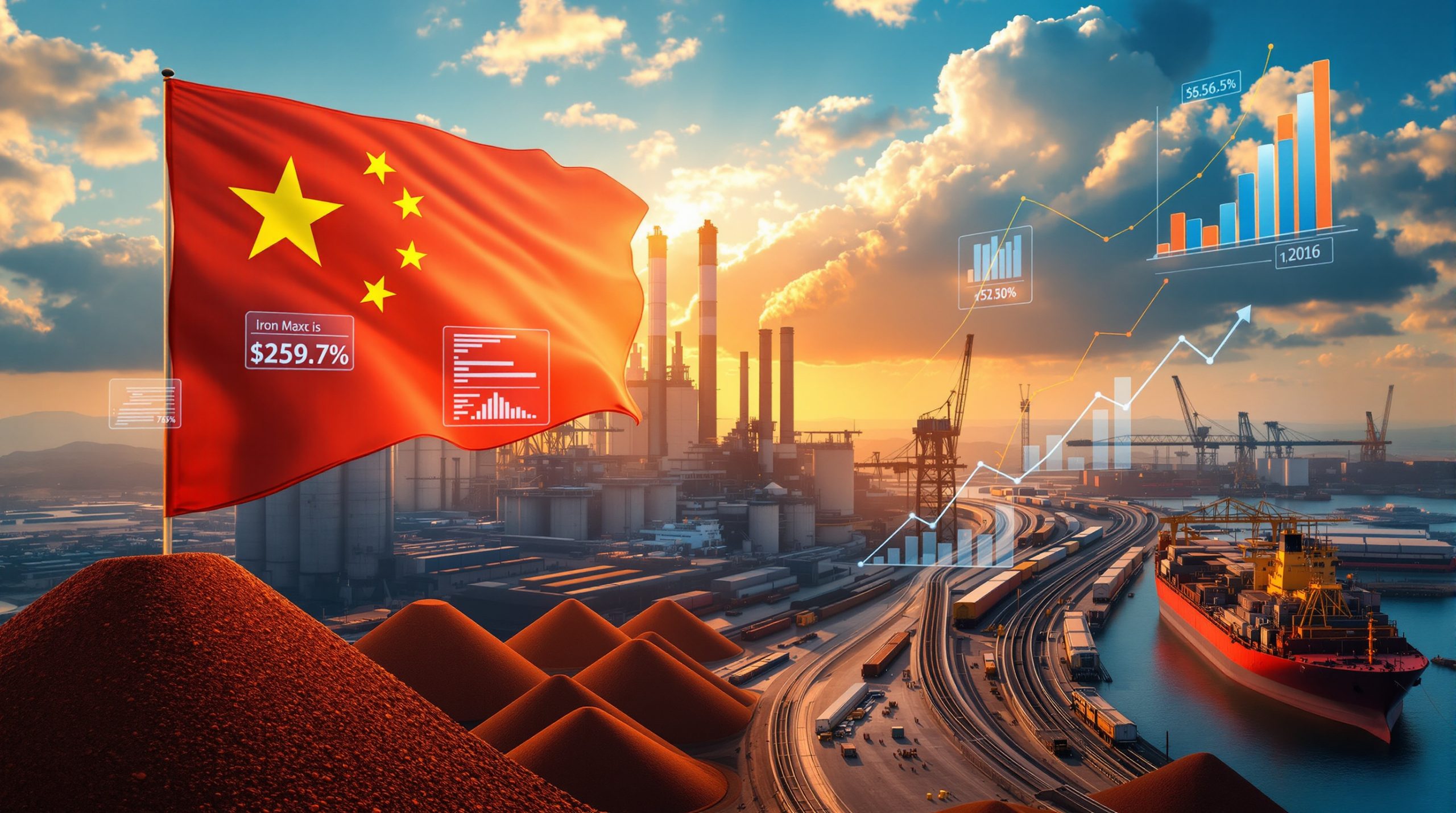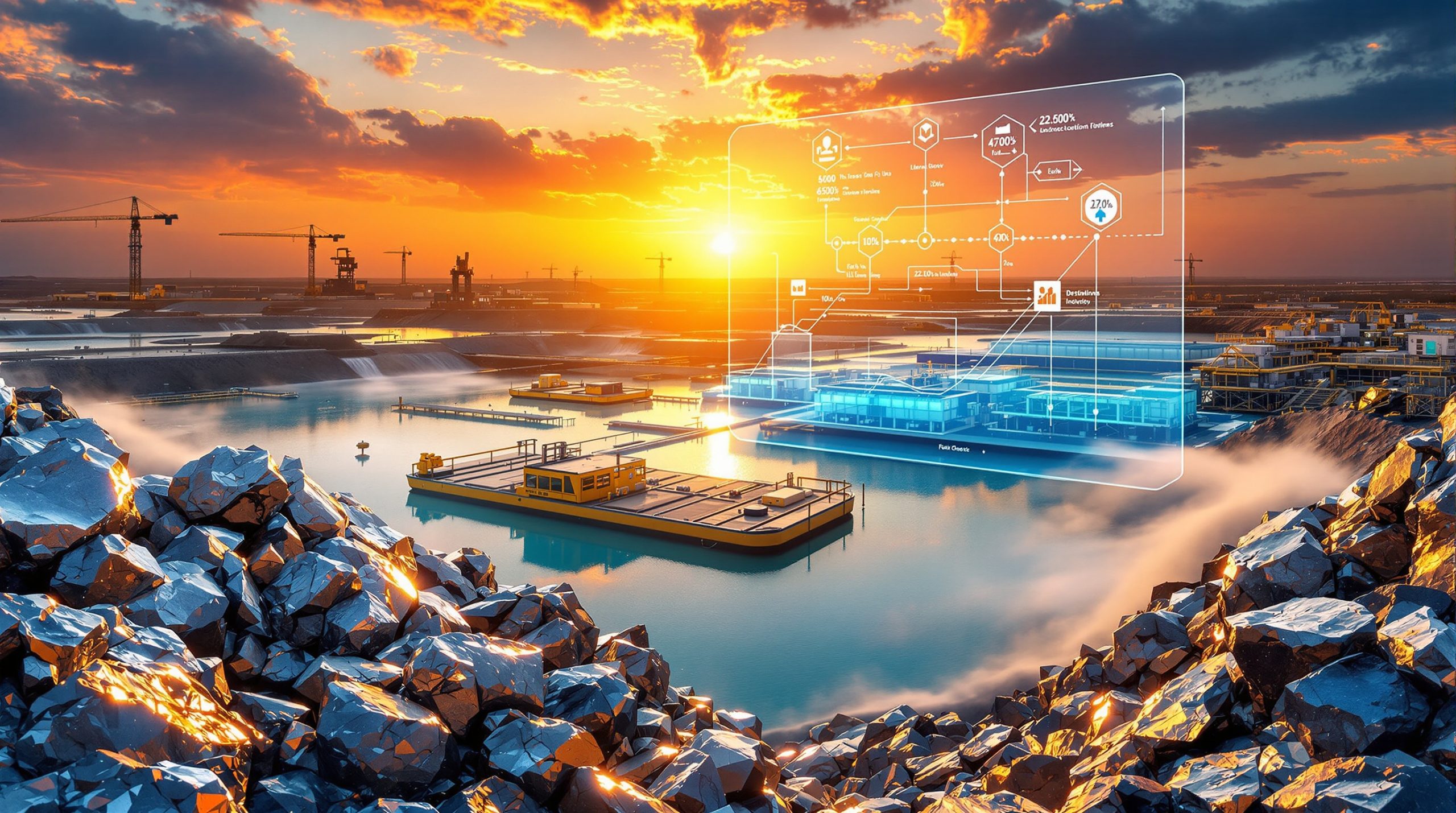China's Growing Arctic LNG Imports: Navigating Sanctions and Energy Security
China has strategically positioned itself as a major buyer of Russian liquefied natural gas (LNG), particularly from Arctic projects under Western sanctions. This growing energy partnership represents a significant shift in global energy trade patterns and highlights China's pragmatic approach to securing energy resources regardless of international political pressures.
The increasing flow of Russian Arctic LNG to Chinese ports demonstrates both countries' determination to deepen energy cooperation despite Western efforts to isolate Russia's energy sector following geopolitical tensions. This relationship is reshaping global LNG trade routes and challenging the effectiveness of international sanctions.
Why Are Russian Arctic LNG Projects Important in Global Energy Markets?
Strategic Significance of Arctic LNG Resources
Russia's Arctic region holds vast natural gas reserves that are being developed into major LNG export projects. These projects represent Russia's ambition to become a dominant global LNG supplier, competing with traditional exporters like Qatar, Australia, and the United States.
Arctic LNG projects benefit from:
- Proximity to Asian markets via the Northern Sea Route
- Lower production costs due to cold ambient temperatures
- Abundant gas reserves in the Yamal and Gydan peninsulas
- Advanced ice-class LNG carrier technology
The flagship projects include Yamal LNG (operational since 2017) and Arctic LNG 2 (partially operational with first train launched in 2023), both representing significant investments in Russia's LNG export capacity. Yamal LNG alone has reached its full 16.5 million tonnes per annum (mtpa) capacity, making it one of the largest LNG facilities in the Northern Hemisphere.
Impact of Western Sanctions on Russian LNG Development
Western sanctions have targeted Russian energy projects, particularly those in the Arctic region, aiming to:
- Restrict access to Western technology and equipment
- Limit financing options for project development
- Prevent Western companies from participating in new projects
- Reduce market access for Russian LNG in Western countries
Despite these challenges, Russia has continued developing its Arctic LNG capacity by:
- Pivoting to Asian markets, particularly China
- Developing domestic technologies to replace Western equipment
- Securing alternative financing through Russian and Asian institutions
- Creating specialized logistics solutions to bypass sanctions
The sanctions have delayed projects but failed to stop them entirely. For example, Arctic LNG 2's first train launched despite sanctions, though its full completion timeline has been extended.
How Has China Emerged as a Key Buyer of Russian Arctic LNG?
China's Strategic LNG Import Decisions
China has systematically increased its imports of Russian LNG, including from sanctioned projects, driven by several strategic considerations:
-
Energy Security Enhancement: Diversifying gas supply sources reduces dependence on any single supplier or route, particularly important given Middle East instability and maritime chokepoint vulnerabilities.
-
Economic Advantages: Russian LNG is often available at competitive prices compared to other suppliers, especially when sanctions create buyer hesitancy in Western markets.
-
Geopolitical Alignment: Energy trade strengthens the broader China-Russia strategic partnership, creating mutual dependencies that benefit both nations' geopolitical positions.
-
Industrial Development: Increased LNG imports support China's industrial policy of shifting from coal to cleaner natural gas for manufacturing and power generation.
Russian LNG fits perfectly into China's dual-circulation economic strategy, which emphasizes both domestic consumption and strategic international partnerships to ensure resource security.
Specific Arctic LNG 2 Import Milestones
China's engagement with sanctioned Russian LNG projects reached a new level in 2025 with several significant developments:
-
First Arctic LNG 2 Cargo: In late August 2025, the specialized ice-class tanker Arctic Mulan delivered the first-ever cargo from the sanctioned Arctic LNG 2 project to China's Beihai LNG terminal in Guangxi province.
-
Dedicated Import Infrastructure: China designated specific terminals, particularly Beihai port in southern China, to handle sanctioned Russian LNG shipments, creating a specialized import channel.
-
Consistent Supply Chain: Following the initial delivery, multiple additional cargoes arrived at Chinese terminals, including the fourth shipment in September 2025 via the sanctioned tanker Buran.
-
Volume Growth: By late 2025, China was receiving regular shipments from Arctic LNG 2, establishing a consistent trade flow despite international sanctions.
These milestones represent a significant breakthrough in sanctions-resistant energy trade, with China effectively creating a parallel import system specifically designed to handle sanctioned Russian LNG products.
What Special Logistics Enable This Sanctions-Navigating Trade?
Specialized Port Infrastructure and Handling
China has developed a sophisticated approach to managing sanctioned Russian LNG imports:
-
Dedicated Terminal Designation: Beihai port in southern China has been specifically configured to receive Arctic LNG shipments, creating a controlled environment for handling sanctioned cargoes.
-
Minimized International Exposure: By limiting sanctioned cargo handling to specific terminals, Chinese companies reduce their international exposure and potential secondary sanctions risks.
-
State-Owned Enterprise Management: Key state-owned companies like CNOOC manage these imports, providing government oversight and coordination of sanctions compliance strategies.
-
Specialized Documentation: Custom documentation and handling procedures help separate these imports from China's broader international trade activities.
This approach allows China to maintain a firewall between sanctioned and non-sanctioned trade activities, reducing compliance risks for its companies operating in international markets.
Specialized Arctic LNG Carrier Fleet
A critical element enabling this trade is the development of specialized ice-class LNG carriers:
-
Arc7 Ice-Class Vessels: These specialized tankers can navigate Arctic waters year-round without icebreaker assistance, opening the Northern Sea Route for regular commercial use. Arc7 vessels can break through ice up to 2.1 meters thick, dramatically extending the shipping season.
-
Chinese-Owned Fleet Components: Vessels like the Arctic Mulan represent China's investment in specialized LNG transportation assets designed specifically for Arctic operations.
-
Alternative Registration: Many vessels operate under flags of convenience to minimize direct connection to sanctions-related restrictions.
-
Integrated Navigation Systems: Advanced ice navigation technology enables year-round operation even in challenging Arctic conditions.
The specialized fleet now includes approximately 15 Arc7 ice-class LNG carriers in service, with additional vessels under construction. This fleet represents a critical logistics link that sanctions cannot easily disrupt.
What Are the Economic Implications of This Energy Partnership?
Price Advantages and Market Dynamics
The Russia-China LNG trade offers significant economic benefits to both parties:
-
Competitive Pricing: Russian LNG typically trades at a discount compared to spot market prices, providing cost advantages to Chinese buyers. In 2025, Russian LNG has been available at approximately 10-15% below prevailing Asian spot prices.
-
Long-Term Contract Security: Many arrangements include long-term supply agreements, providing price stability for Chinese buyers and guaranteed market access for Russian producers.
-
Reduced Price Volatility: Direct bilateral trade reduces exposure to international LNG spot market volatility.
-
Yuan-Based Transactions: Many deals are settled in Chinese yuan rather than US dollars, reducing currency risk and sanctions exposure.
Industry analysts note that by 2025, approximately 60% of Russia-China gas transactions were being conducted in national currencies rather than dollars, creating a parallel payment system largely immune to Western financial sanctions.
Volume and Growth Projections
The scale of China-Russia LNG trade continues to expand:
- Russian LNG exports to China increased by 3.3% in 2024 to 8.3 million tonnes
- Russia ranked as China's third-largest LNG supplier in 2024, behind only Australia and Qatar
- Arctic LNG 2 is expected to contribute an additional 6.6 million tonnes of annual capacity when fully operational
- Combined with existing Yamal LNG volumes, Russian Arctic projects could provide over 15 million tonnes annually to Chinese markets
Despite this growth, Arctic LNG 2 supplies currently represent less than 1% of China's total LNG demand, indicating significant room for expansion. Energy analysts project that Russian Arctic LNG could account for 5-7% of China's gas consumption by 2030.
How Does This Trade Affect Global Energy Geopolitics?
Challenging Western Sanctions Effectiveness
The growing China-Russia LNG trade has significant implications for global sanctions regimes:
-
Sanctions Circumvention: The ability to redirect energy exports from Western to Asian markets undermines the economic impact of sanctions.
-
Alternative Financial Channels: Development of non-dollar payment systems and financial channels reduces the leverage of Western financial sanctions.
-
Technology Transfer: Chinese equipment and technical expertise increasingly substitute for Western technology in Russian energy projects.
-
Diplomatic Leverage: Energy interdependence strengthens both countries' positions in international negotiations and disputes.
Energy security experts note that the continued flow of Russian LNG to China demonstrates the limitations of sanctions in a multipolar world where major powers can create alternative economic systems.
Shifting Global LNG Trade Patterns
This partnership is reshaping global LNG flows:
-
Eastward Pivot: Russian LNG exports are increasingly directed toward Asian rather than European markets.
-
New Shipping Routes: The Northern Sea Route is gaining importance as a commercial shipping corridor, reducing transit times between Europe and Asia.
-
Market Segmentation: The global LNG market is increasingly divided between Western-aligned and non-Western-aligned supply chains.
-
Price Differentials: Regional price disparities are emerging between markets that accept Russian LNG and those that don't.
The Northern Sea Route now handles approximately 35 million tonnes of cargo annually, with LNG shipments constituting a significant portion. This represents a dramatic increase from just 5 million tonnes a decade ago.
What Future Developments Are Expected in China-Russia Gas Trade?
Pipeline Expansion Projects
Beyond LNG, China and Russia are developing additional gas connectivity:
-
Power of Siberia-2 Pipeline: Negotiations continue on this massive pipeline project designed to deliver 50 billion cubic meters of natural gas annually from Russia's Yamal region to China.
-
Technical Challenges: The project faces significant engineering challenges, including permafrost terrain and remote construction locations.
-
Pricing Negotiations: Determining mutually acceptable pricing formulas remains a key negotiation point, with discussions ongoing throughout 2025.
-
Integration with Domestic Networks: China continues expanding its internal gas distribution infrastructure to accommodate increased Russian imports.
The Power of Siberia-2 project would dramatically increase Russia-China gas trade volumes, potentially making China the largest importer of Russian gas globally, surpassing historical European import levels.
Arctic LNG Expansion Outlook
The Arctic LNG sector continues to develop despite sanctions:
-
Arctic LNG 2 Completion: Work continues on the remaining trains of the Arctic LNG 2 project, with full capacity expected to reach 19.8 million tonnes per year.
-
Arctic LNG 3 Planning: Preliminary work has begun on the next major Arctic LNG development, though with adjusted timelines due to sanctions.
-
Technology Indigenization: Russia is accelerating development of domestic LNG technology to reduce dependence on Western equipment.
-
Fleet Expansion: Additional specialized ice-class LNG carriers are under construction to support expanded Arctic LNG exports.
Russia aims to increase its global LNG market share from approximately 8% to 15-20% by 2030, with the majority of this growth directed toward Asian markets, further strengthening the OPEC oil market influence on energy pricing.
What Are the Environmental Considerations of Arctic LNG Development?
Arctic Ecosystem Impacts
The rapid development of Arctic energy resources raises environmental concerns:
-
Sensitive Ecosystem Disruption: The Arctic's fragile ecosystems face potential disruption from industrial development and increased shipping.
-
Oil Spill Risks: The challenging Arctic environment complicates oil spill response capabilities, with cleanup techniques limited by ice conditions.
-
Permafrost Thawing: Climate change is already affecting Arctic infrastructure through permafrost thaw, creating additional challenges for project development.
-
Indigenous Communities: Development impacts traditional livelihoods of indigenous Arctic populations.
Environmental monitoring indicates that shipping along the Northern Sea Route has increased black carbon emissions in the region by approximately 20% since 2020, accelerating ice melt. The upcoming OPEC meeting insights will likely address some of these environmental concerns.
Climate Policy Contradictions
The expansion of natural gas infrastructure presents climate policy contradictions:
-
Transition Fuel Arguments: Natural gas is positioned as a transition fuel that produces fewer emissions than coal when burned.
-
Methane Leakage Concerns: Significant methane leakage during production and transportation can offset climate benefits. Studies suggest leakage rates in Arctic operations may be 2-3% higher than in conventional gas fields.
-
Long-Term Infrastructure Lock-in: Major gas infrastructure investments create decades-long commitments to fossil fuel use.
-
Carbon Intensity Variations: Arctic LNG production may have different carbon intensity profiles compared to conventional gas production.
Climate researchers note that while LNG produces roughly half the CO2 emissions of coal when burned, lifecycle analysis including methane leakage and energy-intensive liquefaction processes make the climate benefits less clear-cut.
How Are Other Countries Responding to China's Russian LNG Imports?
Varied International Reactions
Different countries have responded differently to China's increased Russian LNG imports:
-
United States: Expressed concern about sanctions evasion while maintaining its own LNG export relationship with China. The ongoing US‑China trade war effects complicate this relationship further.
-
European Union: Focused on reducing its own Russian gas dependence while acknowledging limited leverage over China's energy choices. The EU has set January 2028 as its target date for ending Russian energy imports.
-
Japan and South Korea: Maintaining more cautious approaches to Russian LNG while watching China's moves closely.
-
India: Showing interest in Russian energy but more hesitant than China to directly challenge Western sanctions on Arctic LNG 2.
Energy diplomacy experts note that the U.S. faces a strategic dilemma: pushing China too hard on Russian energy imports could drive an even deeper China-Russia alignment, while ignoring the trade undermines sanctions effectiveness.
Sanctions Enforcement Challenges
The growth in China-Russia energy trade highlights sanctions enforcement limitations:
-
Secondary Sanctions Considerations: The U.S. faces difficult decisions about whether to impose secondary sanctions on Chinese entities.
-
Economic Interdependence: Deep economic ties between China and Western economies complicate sanctions enforcement.
-
Technical Compliance Mechanisms: Companies develop increasingly sophisticated methods to maintain technical compliance while achieving desired trade outcomes.
-
Diplomatic Balancing: Western countries must balance sanctions enforcement against other diplomatic priorities with China.
The Trump administration has discussed potential tariffs and market impact on countries that purchase significant quantities of Russian oil and gas, but implementation challenges remain substantial, particularly regarding China. Recent analysis also suggests that US tariffs and inflation concerns may influence this policy approach.
What Does This Mean for Global Energy Security?
Diversification vs. Dependency
The China-Russia energy relationship creates complex security dynamics:
-
Chinese Supply Diversification: For China, Russian LNG represents diversification away from Middle Eastern and maritime chokepoint-vulnerable supplies.
-
Russian Market Diversification: For Russia, China provides an alternative to traditional European markets increasingly closed due to political tensions.
-
New Dependencies: However, this creates new dependencies, with Russia increasingly reliant on Chinese markets and China increasing its Russian energy exposure.
-
Global Market Fragmentation: The broader trend suggests a more fragmented global energy market with distinct geopolitical blocs.
Energy security analysts estimate that by 2030, Russia could supply up to 25% of China's total natural gas consumption, creating a significant energy interdependency between the two powers.
Technology and Infrastructure Implications
The development of specialized Arctic energy infrastructure has broader implications:
-
Arctic Shipping Route Development: Increased LNG shipping helps establish the Northern Sea Route as a viable commercial corridor.
-
Cold-Climate Technology Advancement: Specialized technologies developed for Arctic conditions may have applications in other extreme environments.
-
LNG Terminal Flexibility: Chinese terminals receiving Russian LNG demonstrate the adaptability of import infrastructure to changing supply sources.
-
Digital Infrastructure: Advanced monitoring and control systems are being developed to manage remote Arctic operations.
The Northern Sea Route potentially reduces shipping times between Asia and Europe by 10-15 days compared to traditional Suez Canal routes, creating significant logistics advantages beyond just energy trade.
Conclusion: The Future of China-Russia Arctic Energy Cooperation
China's increasing imports of Russian Arctic LNG, including from sanctioned projects like Arctic LNG 2, represent a significant development in global energy geopolitics. This growing energy partnership demonstrates both countries' determination to pursue their strategic interests despite Western sanctions and political pressure.
The specialized logistics, dedicated port infrastructure, and growing fleet of ice-class LNG carriers enabling this trade highlight the sophisticated strategies being employed to navigate sanctions regimes. Meanwhile, the economic benefits—including competitive pricing and supply security—provide strong incentives for both parties to deepen their energy relationship.
As this partnership continues to evolve, it will likely reshape global LNG trade patterns, challenge the effectiveness of international sanctions, and influence energy security calculations worldwide. The development of additional pipeline connections and expanded Arctic LNG capacity suggests this trend will continue, potentially accelerating the fragmentation of the global energy market into distinct geopolitical spheres.
For global energy markets, this relationship underscores the growing importance of understanding not just traditional supply-demand dynamics, but also the complex interplay of geopolitics, sanctions regimes, and strategic national interests that increasingly shape international energy flows.
Disclaimer: This article provides analysis based on current market conditions and expert opinions. Energy markets are subject to rapid changes due to geopolitical developments, regulatory shifts, and technological advancements. Readers should consider these factors when making energy-related decisions.
Curious About Real-Time Mineral Discovery Notifications?
Stay ahead of the market with Discovery Alert's proprietary Discovery IQ model, which instantly identifies significant ASX mineral discoveries and transforms complex data into actionable insights. Explore Discovery Alert's dedicated discoveries page to understand how major mineral discoveries have generated substantial returns for early investors.




